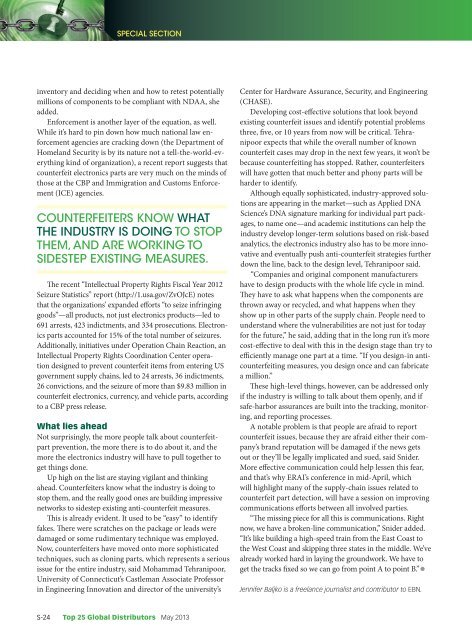201305.pdf 43279KB May 08 2013 11:07:04 PM
201305.pdf 43279KB May 08 2013 11:07:04 PM
201305.pdf 43279KB May 08 2013 11:07:04 PM
Create successful ePaper yourself
Turn your PDF publications into a flip-book with our unique Google optimized e-Paper software.
special sectioninventory and deciding when and how to retest potentiallymillions of components to be compliant with NDAA, sheadded.Enforcement is another layer of the equation, as well.While it’s hard to pin down how much national law enforcementagencies are cracking down (the Department ofHomeland Security is by its nature not a tell-the-world-everythingkind of organization), a recent report suggests thatcounterfeit electronics parts are very much on the minds ofthose at the CBP and Immigration and Customs Enforcement(ICE) agencies.counterfeiters know whatthe industry is doing to stopthem, and are working tosidestep existing measures.The recent “Intellectual Property Rights Fiscal Year 2012Seizure Statistics” report (http://1.usa.gov/ZvOJcE) notesthat the organizations’ expanded efforts “to seize infringinggoods”—all products, not just electronics products—led to691 arrests, 423 indictments, and 334 prosecutions. Electronicsparts accounted for 15% of the total number of seizures.Additionally, initiatives under Operation Chain Reaction, anIntellectual Property Rights Coordination Center operationdesigned to prevent counterfeit items from entering USgovernment supply chains, led to 24 arrests, 36 indictments,26 convictions, and the seizure of more than $9.83 million incounterfeit electronics, currency, and vehicle parts, accordingto a CBP press release.What lies aheadNot surprisingly, the more people talk about counterfeitpartprevention, the more there is to do about it, and themore the electronics industry will have to pull together toget things done.Up high on the list are staying vigilant and thinkingahead. Counterfeiters know what the industry is doing tostop them, and the really good ones are building impressivenetworks to sidestep existing anti-counterfeit measures.This is already evident. It used to be “easy” to identifyfakes. There were scratches on the package or leads weredamaged or some rudimentary technique was employed.Now, counterfeiters have moved onto more sophisticatedtechniques, such as cloning parts, which represents a seriousissue for the entire industry, said Mohammad Tehranipoor,University of Connecticut’s Castleman Associate Professorin Engineering Innovation and director of the university’sCenter for Hardware Assurance, Security, and Engineering(CHASE).Developing cost-effective solutions that look beyondexisting counterfeit issues and identify potential problemsthree, five, or 10 years from now will be critical. Tehranipoorexpects that while the overall number of knowncounterfeit cases may drop in the next few years, it won’t bebecause counterfeiting has stopped. Rather, counterfeiterswill have gotten that much better and phony parts will beharder to identify.Although equally sophisticated, industry-approved solutionsare appearing in the market—such as Applied DNAScience’s DNA signature marking for individual part packages,to name one—and academic institutions can help theindustry develop longer-term solutions based on risk-basedanalytics, the electronics industry also has to be more innovativeand eventually push anti-counterfeit strategies furtherdown the line, back to the design level, Tehranipoor said.“Companies and original component manufacturershave to design products with the whole life cycle in mind.They have to ask what happens when the components arethrown away or recycled, and what happens when theyshow up in other parts of the supply chain. People need tounderstand where the vulnerabilities are not just for todayfor the future,” he said, adding that in the long run it’s morecost-effective to deal with this in the design stage than try toefficiently manage one part at a time. “If you design-in anticounterfeitingmeasures, you design once and can fabricatea million.”These high-level things, however, can be addressed onlyif the industry is willing to talk about them openly, and ifsafe-harbor assurances are built into the tracking, monitoring,and reporting processes.A notable problem is that people are afraid to reportcounterfeit issues, because they are afraid either their company’sbrand reputation will be damaged if the news getsout or they’ll be legally implicated and sued, said Snider.More effective communication could help lessen this fear,and that’s why ERAI’s conference in mid-April, whichwill highlight many of the supply-chain issues related tocounterfeit part detection, will have a session on improvingcommunications efforts between all involved parties.“The missing piece for all this is communications. Rightnow, we have a broken-line communication,” Snider added.“It’s like building a high-speed train from the East Coast tothe West Coast and skipping three states in the middle. We’vealready worked hard in laying the groundwork. We have toget the tracks fixed so we can go from point A to point B.”•Jennifer Baljko is a freelance journalist and contributor to EBN.S-24 Top 25 Global Distributors <strong>May</strong> <strong>2013</strong>






![[270].pdf 37407KB Sep 02 2010 09:55:57 AM - ElectronicsAndBooks](https://img.yumpu.com/50350834/1/185x260/270pdf-37407kb-sep-02-2010-095557-am-electronicsandbooks.jpg?quality=85)
![draaien, A Viruly 1935 OCR c20130324 [320]. - ElectronicsAndBooks](https://img.yumpu.com/49957773/1/190x252/draaien-a-viruly-1935-ocr-c20130324-320-electronicsandbooks.jpg?quality=85)



![20051110 c20051031 [105].pdf 35001KB Feb 18 2009 08:46:32 PM](https://img.yumpu.com/48687202/1/190x253/20051110-c20051031-105pdf-35001kb-feb-18-2009-084632-pm.jpg?quality=85)




